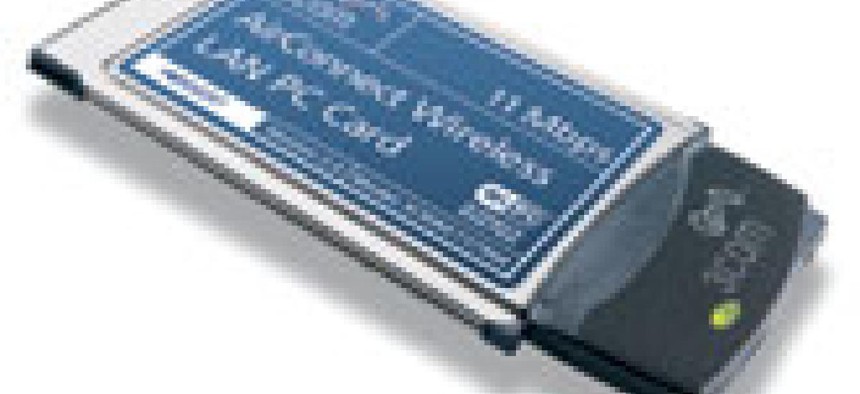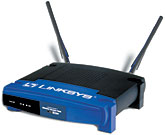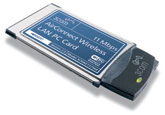It's a paradox: Just as wireless networking based on one of the IEEE 802.11 standards should be hitting its stride in government agencies, a number of challenges are nipping at its heels.First there's the emerging variety of wireless networking standards: 802.11b, 802.11g and 802.11a.The 802.11b standard, also known as Wi-Fi, is the most widespread. The number of Wi-Fi devices has exploded while prices have fallen.Wireless analysts Philip Marshall and Sarah Kim of the Yankee Group in Boston estimate that 27 million units of wireless LAN gear will be sold worldwide in 2004, with about 60 percent of that being sold in the United States. A maker of chip sets for 802.11 devices, Intersil Corp. of Irvine, Calif., predicts that the approximately 15 million installed users of 802.11b in the United States will double to about 30 million this year.On the horizon are both 802.11g, which promises more coverage for wireless access points, and 802.11a, which promises more capacity. Both would have faster transmission speeds'up to 54 Mbps'than Wi-Fi's maximum of 11 Mbps.While 802.11a systems are not backward-compatible with 802.11b, 802.11g systems would accommodate and recognize the older standard's wireless antenna cards. Sorting all this out could become a headache for IT managers'and the users they support.Then, there's been the on-and-off nature of public 802.11b connections. Over the past two years, wireless Internet access in hotels, airports and even Starbucks coffee shops was touted as a tremendous advantage to road warriors who need to keep in touch with the home office. But the bankruptcy of wireless access provider MobileStar Network Corp. of Richardson, Texas, raised questions about the long-term stability of some services, as users faced rolling cutoffs or delays in service.But perhaps the biggest challenge to wireless networking's growth is security.In January, the Energy Department's Lawrence Livermore National Laboratory, one of the nation's premier nuclear research facilities, instituted a ban on wireless LANs over concerns that someone could eavesdrop on sensitive data transmissions.'The very attributes that make wireless network communication attractive create serious security issues for protection of those networks and the information they transmit,' acting CIO Ted Michels wrote in Livermore's employee newsletter Jan. 18. Livermore officials plan to reevaluate wireless use as technologies develop.Much of the current concern about Wi-Fi security centers on the algorithm used to encrypt data, known as the Wired Equivalent Privacy standard. WEP is based on the RC4 stream cipher and, according to security experts such as Scott Fluher of Cisco Systems Inc., is also easy to breach.Dennis Eaton, a product manager at Intersil, said taking precautions is a sensible strategy.'Obviously some place like Livermore is likely to have pretty sensitive data,' he said. 'What they did was a temporary ban, suspending the use while they can identify some alternatives for identifying the network.'Eaton said a special Institute of Electrical and Electronics Engineers committee is looking for ways to overcome the security gaps.One strategy calls for upgrading current Wi-Fi devices with a protocol that will be built in to future chip sets, Temporal Key Integrity Protocol.Beyond TKIP, there also is the new Advanced Encryption Standard containing the Rijndael data encryption formula, whose selection as a Federal Information Processing Standard was announced in December.The National Institute of Standards and Technology said Rijndael (pronounced Rhine-doll) was selected 'because it had the best combination of security, performance, efficiency, implementability and flexibility.' It will replace the Data Encryption Standard, which will be phased out as a FIPS, although Triple DES is expected to remain ().AES also is expected to be a component of the 802.11i standard for WLAN security, due to be announced by IEEE later this year, Eaton said.Meanwhile, users should weigh the sensitivity of information in their networks when deploying wireless LANs, he said, and use the current WEP tools if available.'Even with WEP being as weak as it is, individual users should still turn it on; it thwarts the casual snooper,' Eaton said. 'All users of wireless equipment should look at the data going over the network and employ a solution consistent with that. If it means using a VPN [to protect a network], then that's what you should do.'While security concerns over 802.11b are being addressed, the next battle will be whether users go for 802.11a or 802.11g. Products for the two higher-speed WLAN standards are due later this year.Both emerging specifications promise faster data transmission speeds'up to 54 Mbps. Their differences involve which part of the radio frequency spectrum they use, the range of wireless access points for each standard, compatibility with 802.11b gear and how crowded the different radio bands might be.Transmitters for 802.11g use the same part of the spectrum, 2.4 GHz, as does Wi-Fi, which would be able to work with the new standard. But critics of 802.11g claim that the 2.4-GHz band is crowded with interference from wireless phones, microwave ovens and other devices. They say that, with the 4.5-MHz width of the Wi-Fi signal, 802.11g WLANs could use only three of the 13 channels available at 2.4 GHz.But supporters of 802.11g say it will have wider coverage within buildings, along with compatibility with older devices.Intersil and Cisco are collaborating on a high-speed WLAN client adapter reference design that will comply with the 802.11g draft standard. The design, which will be compatible with Cisco WLAN infrastructures, will be offered to third-party manufacturers.Advocates of 802.11a say that, while their products might not have the range of 802.11g, their standard has the advantage of being in a less-crowded part of the spectrum, at 5 GHz.Jim Harrington of Linksys Group Inc. said he thinks the market will ultimately move toward 802.11a gear.'802.11a is going to be early to take hold, and we decided to take extra time in development instead of rushing it to market,' he said. 'Towards the end of next year, 802.11a will be the dominant choice for wireless networks.'But even Harrington is hedging his bets: The company will continue to offer 802.11b gear, he said, to see what users prefer.
Linksys Group Inc.'s Instant Wireless Network Access Point works with virtually all OSes and is Wi-Fi compliant. It's priced at $169.
3Com Corp.'s AirConnect Wireless LAN PC Card works with Microsoft Windows systems and includes a software installation wizard. It's priced at $86.








